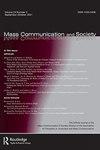“饶了我吧!”COVID-19大流行期间故意回避新闻的患病率和预测因素
IF 2.7
2区 文学
Q1 COMMUNICATION
引用次数: 6
摘要
故意回避新闻描述了一种间歇性新闻使用行为,人们故意避开新闻。此前的研究结果指出,自2019冠状病毒病大流行以来,故意回避新闻的程度有所增加。由于这可能与遵守措施和新闻经济状况的负面影响有关,因此本研究实证调查了COVID-19期间故意回避新闻的流行程度和预测因素。为此,我们分析了奥地利冠状病毒小组的两个波(2020年4月n = 1459, 2020年5月n = 1433),其中包括新闻回避和潜在预测因素的相关措施。我们的研究结果表明,绝大多数参与者至少有时会避开有关COVID-19的新闻(4月为75%,5月为80%)。这种行为可以解释为对有关COVID-19的新闻缺乏信任以及对新闻的负面情绪反应(例如信息过载或情绪困扰)。总而言之,新闻回避的高流行率可以被认为是大流行的总体负担的结果,但也是对媒体作用的不满。本文章由计算机程序翻译,如有差异,请以英文原文为准。
“Give Me a Break!” Prevalence and Predictors of Intentional News Avoidance During the COVID-19 Pandemic
ABSTRACT Intentional news avoidance describes an intermittent news use practice in which people deliberately turn away from the news. Previous findings point out that the level of intentional news avoidance has increased since the COVID-19 pandemic. Since this might be related to negative consequences both with regard to compliance with measures and for the economic situation of journalism, the current study empirically investigates the prevalence and predictors of intentional news avoidance during COVID-19. For this purpose, we analyze two waves (April 2020 n = 1459, May 2020 n = 1433) of the Austrian Corona Panel that include relevant measures for news avoidance and potential predictors. Our findings show that the vast majority of the participants at least sometimes avoid news about COVID-19 (75% in April and 80% in May). This behavior can be explained by a lack of trust in news about COVID-19 and negative emotional responses to news (e.g. information overload or emotional distress). In sum, the high prevalence of news avoidance can be considered a result of the general burden of the pandemic, but also dissatisfaction with the role of the media.
求助全文
通过发布文献求助,成功后即可免费获取论文全文。
去求助
来源期刊

Mass Communication and Society
COMMUNICATION-
CiteScore
6.90
自引率
3.30%
发文量
58
期刊介绍:
Mass Communication and Society" mission is to publish articles from a wide variety of perspectives and approaches that advance mass communication theory, especially at the societal or macrosocial level. It draws heavily from many other disciplines, including sociology, psychology, anthropology, philosophy, law, and history. Methodologically, journal articles employ qualitative and quantitative methods, survey research, ethnography, laboratory experiments, historical methods, and legal analysis.
 求助内容:
求助内容: 应助结果提醒方式:
应助结果提醒方式:


